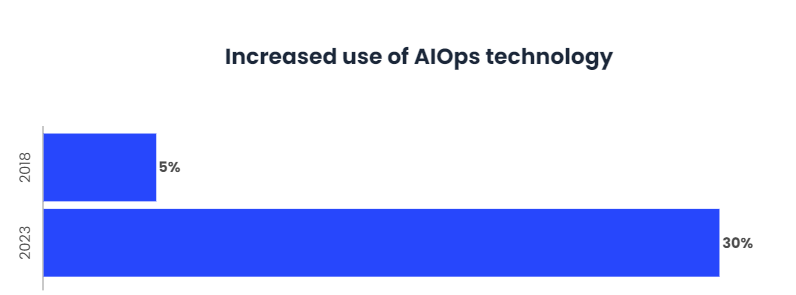Transforming IT operations with AIOps

The digital transformation, changes and evolution of technology, new initiatives that are emerging in terms of customer experience and the rapid growth in the volumes of data generated, pose challenges to IT operations. Similarly, the need for real-time decision making has increased due to the large volumes of data and analysis.
These challenges make traditional information parameterization, monitoring, IT operations management, and tracking obsolete and inadequate, rendering the process of extracting value from data unusable.
IT operations need help to reduce the noise of daily operations, quickly identify and fix problems, automate repetitive tasks to increase efficiency, and focus on value-added activities. To do this, IT organizations need a new kind of technology to modernize their processes, and this is where AIOps technology that has been developed in recent years comes in.
The road to AIOps
Traditional IT management techniques have been deemed unable to cope with the digital transformation of the business. This digital transformation encompasses DevOps, the migration of enterprises to the cloud, an increase in the pace of innovation and implementation and the acquisition of new digital users (IoT, APIs, etc.) that organizations previously did not need to serve. All these new technologies and users are forcing traditional service and performance management strategies and tools to the point of total obsolescence. AIOps is the ITOps paradigm shift needed to solve these digital transformation problems.
Interest in and adoption of AIOps has increased exponentially in recent years as organizations have improved their innovations, tried to compete with disruptive businesses, and attempted to manage the speed, volume and variety of digital data.
In fact, according to the data, the market size for AIOps is estimated to be increasing by $300 million to $500 million per year, and its use will grow from 5% in 2018 to 30% in 2023, primarily because more and more organizations plan to invest in this technology.

What is AIOps?
AIOps stands for Artificial Intelligence to improve IT operations. Specifically, AIOps uses Big Data, data analysis and Machine Learning capabilities to do the following:
- Collect, aggregate and process large volumes of data generated by different IT operations tools and devices to automatically detect and react to problems in real time and assist with the resolution of necessary tasks.
- Identify significant events and patterns related to system performance and availability issues
- Diagnose the causes of the problem and report them to IT for faster response and resolution, or in some cases even automatically resolve those problems without human intervention
- Automate more routine tasks so IT teams can stop doing more manual work and focus on other tasks
By replacing the use of multiple IT operations tools with a single, intelligent, automated tool such as AIOps, IT teams can respond more quickly and proactively to potential problems.
This technology solves problems that were beginning to emerge in the changing and complex IT landscape and meets user expectations for performance and availability disruptions. Most experts see AIOps as the future of IT operations management.
Main benefits
The main, and most obvious, benefit of AIOps technology is that it enables IT operations to identify, address and resolve problems, slowdowns and disruptions more quickly than would be possible manually or through the use of multiple IT operations tools. This results in a number of specific benefits:
- Faster problem solving: AIOps can identify the causes of the problem and propose solutions more quickly and accurately than if it were done manually.
- Reduction of false alarms: AIOps systems have a history of errors, problems and solutions that increases as they are used, thanks to this history AIOps can separate the ‘noise’ (which is not important) and determine when an action is really necessary.
- Predictive alerts: AIOps learns to identify problems that, although they may seem minor at first, are likely to lead to serious or urgent problems. This means it can provide predictive alerts that help IT teams address potential problems before they become serious.
- Identifying the source of the problem: These systems are also very good at finding, among a lot of data, the source of a particular problem, so the IT team does not need to do a broad search to find the solution.
- Improved decision making: By using AIOps’ ability to analyze data, predictive analysis and previewing that data in graphs, decision making is better informed. Better decisions can be made in terms of resource utilization, application performance and customer service.
- Reduced staff workload: With automation and the improved problem identification and prioritization capabilities of AIOps, IT staff are freed from heavy and more routine tasks.
- Modernization of operations and IT equipment.
Main challenges
Despite all the benefits that AIOps offers, the implementation of this type of tool is not perfect. As with any system that introduces significant changes to IT processes and transforms the responsibilities of team members, AIOps can appear to be a threat to workers. And this idea of job loss or reassignment can lead to organizational challenges that companies must address:
- Ignorance of the tool: It’s very difficult to automate something you don’t understand. AIOps tools automate many of the tasks, but it is not a completely autonomous tool, it needs a person who understands its operation.
- Lack of worker skills: AIOps takes care of the more routine tasks that do not require great skill, freeing up IT staff to focus on higher value tasks, such as system optimization and process improvements.But, if the skills of those IT staff are limited to the tasks that AIOps can perform, a problem will be created.
- Staff refusal to adapt: If employees feel threatened by AIOps software, they may refuse to adapt.
- Focusing on the wrong goals: It is a mistake to focus on the number of performance issues or errors detected by AIOps, rather than on larger strategic goals such as reducing costs, better resource utilization, improved application performance, or faster problem resolution.
Conclusions
As Information Technology overcomes the barrier of what humans can do, IT tools must adapt. Organizations that adopt AIOps will see the potential challenges it must address as an opportunity to grow, evolve and innovate. In addition, they will see their business transformed, over the next five years, in the following way:
- Technology will become more humane.
- The automation of technology and therefore of business processes will lead to lower costs, increased speed and fewer errors.
- The large amount of untapped business data will bring opportunities for monetization.
By combining Big Data, machine learning, data visualization and programmable process automation with IT operations management, AIOps adoption is the key indicator of the digital enterprise’s path.


